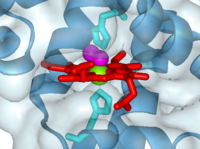Molecular model:
The initial view here is a ball-and-stick representation of the molecular structure of myoglobin.
SECONDARY STRUCTURE: This next view simplifies things, and just shows a of the secondary structure of the protein.
You see how the (yellow) that maintain the main secondary structure of the protein are arranged in this next view.
Some amino acids have specific effects on secondary structure. This next view shows the locations of the residues in myoglobin. You can see that they all fall at the end of a stretch of helix. This is bacause their large side chains do not fit within the straight run of α-helix.
THE GLOBIN FOLD: In this next view, the eight are each coloured differently. This gives you an impression of the classic globin fold. The α-helices pack together tightly, and there is very little space in the centre of the protein.
HYDROPHOBICITY: Globular folds like this are characterised by a polar, , which interacts with the aqueous solvent, and a hydrophobic core.
Hydrophobic, Polar
The next view shows a section through the protein that highlights the better.
This view has been produced in the software by a process known as 'slabbing'. You can still rotate the molecule around - whatever view you see will have the front part of the view of the protein cut off.
The Heme Group
Now let's turn our attention to the main function of myoglobin - oxygen binding.
Oxygen is bound by a , (coloured red) which sits in a hydrophobic pocket in the myoglobin protein.
Central to the heme group is an .
PROXIMAL AND DISTAL HISTIDINES: The iron atom sits either side of the side chains of two .
One of these (coloured cyan) is attached to the iron atom, and is known as the proximal histidine. The other (green) is called the distal histidine.
OXYGEN:
The space between the iron and the distal histidine is where the (pink) binds.

